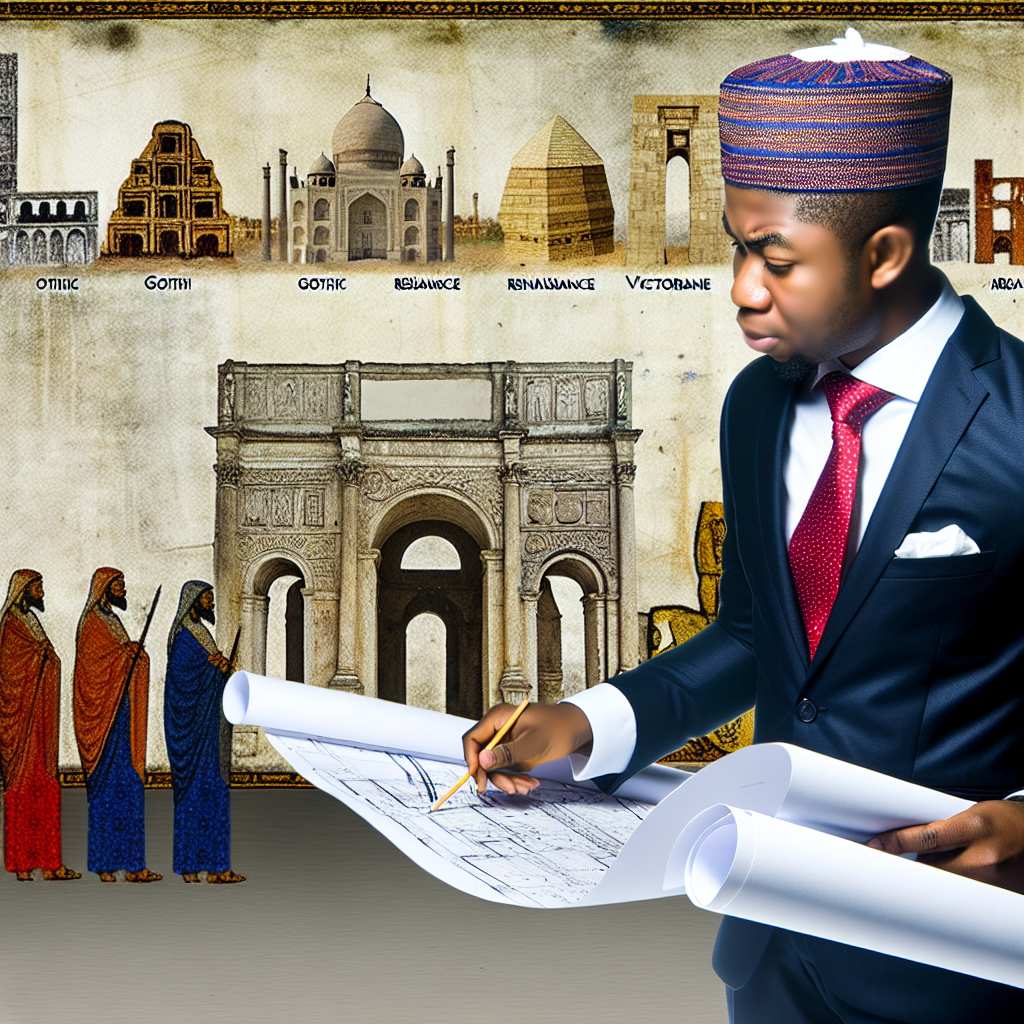Introduction
In Nigeria, architecture plays a pivotal role in reflecting the country’s rich history and cultural heritage.
Understanding key milestones in Nigerian architecture is crucial for appreciating its evolution over time.
Pre-colonial architecture
Traditional Nigerian architectural styles and construction methods have a rich history that dates back centuries.
These architectural styles were influenced by various factors such as climate, culture, and available resources.
Influence of climate
The diverse climate in Nigeria played a significant role in shaping the architectural design of buildings.
For example, in regions with high rainfall, structures were built with steep roofs to allow rainwater to run off quickly and prevent water damage.
Influence of culture
The cultural beliefs and practices of different ethnic groups in Nigeria also influenced architectural design.
For instance, the Yoruba people built their houses with courtyards as a central feature, reflecting the importance of communal living and family ties.
Influence of resources
The availability of materials such as mud, thatch, wood, and stone impacted the construction methods used by various Nigerian communities.
Mud houses were prevalent in areas where clay soil was abundant, while stone buildings were more common in regions with access to quarries.
Examples of pre-colonial architectural landmarks in Nigeria
- The Nri Palace in Anambra State is an excellent example of traditional Nigerian architecture, characterized by intricate mud walls and wooden carvings.
- The Kano City Walls in Kano State represent a significant pre-colonial architectural feat, consisting of large mud walls that once surrounded the ancient city.
- The Oba’s Palace in Benin City showcases the skilled craftsmanship of traditional builders, with its elaborate wooden designs and carvings.
Pre-colonial architecture in Nigeria is a testament to the creativity and ingenuity of the country’s diverse ethnic groups.
The architectural styles and construction methods used in the past continue to inspire modern designers and architects, highlighting the enduring legacy of Nigeria’s rich architectural heritage.
Colonial Architecture
The impact of British colonization on Nigerian architecture was profound.
It shaped the built environment in significant ways.
Introduction of European Architectural Styles and Materials
British colonization brought with it European architectural styles.
These styles include neoclassical, gothic, and Victorian.
They heavily influenced the design of buildings in Nigeria.
Materials such as bricks, iron, and glass were introduced.
This replaced traditional building materials like mud bricks and thatch roofs.
Construction of Government Buildings, Churches, and Other Colonial Structures
One of the key features of colonial architecture in Nigeria was the construction of government buildings.
Churches and other colonial structures also emerged.
These buildings served as administrative centers.
They were designed to reflect the power and authority of the British colonial government.
The architecture often featured grand facades and imposing structures.
Colonial architecture in Nigeria represented a blend of indigenous building techniques.
It combined these with European design influences.
The result is a unique architectural style that continues to shape the country’s built environment to this day.
Delve into the Subject: Innovations in Nigerian Materials Engineering Education
Post-independence architecture
In the years following Nigeria’s independence in 1960, the architectural landscape of the country underwent significant changes.
This period marked a transition from traditional styles to modern architectural designs.
Transition to modern architectural styles in Nigeria
- Architects began to incorporate modern materials and techniques into their designs.
- Buildings featured clean lines, minimalist aesthetics, and innovative use of space.
- The influence of international architectural trends became more prevalent in Nigeria.
Rise of Nigerian architects and architectural firms
- Nigerian architects gained recognition both at home and abroad for their innovative designs.
- Local architectural firms flourished, taking on major projects across the country.
- These architects played a crucial role in shaping the urban landscape of post-independence Nigeria.
Construction of iconic buildings and landmarks in post-independence Nigeria
- One of the most iconic structures built during this period is the National Arts Theatre in Lagos.
- Other notable landmarks include the Central Bank of Nigeria building in Abuja.
- These buildings not only served practical purposes but also became symbols of Nigeria’s growth and development.
The post-independence era saw a shift towards modern architectural styles and the rise of Nigerian architects.
They made significant contributions to the built environment of the country.
You Might Also Like: Agricultural Engineering Internships: How to Find One
Contemporary architecture in Nigeria
Contemporary architecture in Nigeria is characterized by a harmonious blend of traditional and modern design elements.
Architects in the country are increasingly turning towards sustainable and eco-friendly practices to address environmental challenges.
Current architectural trends and practices in Nigeria
- Adoption of innovative design techniques
- Exploration of new materials and construction methods
- Incorporation of smart technology in building designs
- Emphasis on creating functional spaces that cater to the needs of the users
Integration of traditional and modern architectural elements
One of the defining features of contemporary architecture in Nigeria is the seamless integration of traditional and modern architectural elements.
Architects draw inspiration from indigenous Nigerian architecture while incorporating contemporary design principles to create unique and culturally relevant structures.
Sustainable and eco-friendly architecture in Nigeria
- Use of locally sourced and sustainable materials
- Implementation of passive design strategies to reduce energy consumption
- Integration of green spaces and vegetation in building designs
- Emphasis on water conservation and efficient waste management practices
Architects in Nigeria are increasingly focusing on creating buildings that are not only aesthetically pleasing but also environmentally responsible.
Transform Your Career with Expert Guidance
Get personalized mentorship consulting that’s tailored to your unique path. Our expert advice is actionable and exclusive.
Get StartedBy adopting sustainable and eco-friendly practices, they are contributing to the preservation of the natural environment and the well-being of future generations.
Learn More: Top Nigerian Universities Offering Metallurgical Engineering

Challenges and Opportunities
Preservation of historic buildings and cultural heritage in Nigeria:
- Lack of funding for maintenance and restoration projects.
- Inadequate awareness and appreciation of historical significance.
- Urban encroachment threatening the survival of heritage sites.
- Lack of proper documentation and protection of cultural artifacts.
Urbanization and its impact on Nigerian architecture:
- Rapid urban growth leading to architectural homogenization.
- Displacement of traditional building techniques and materials.
- Pressure on infrastructure and services in urban centers.
- Loss of green spaces and cultural identity in urban areas.
Opportunities for innovation and development in the Nigerian architectural sector:
- Integration of sustainable design principles into new projects.
- Adoption of technology for efficient construction practices.
- Promotion of indigenous architectural styles and materials.
- Collaboration with international architects for knowledge exchange.
Nigeria faces challenges in preserving its architectural heritage.
It must manage the impacts of urbanization.
There are also opportunities for innovation and growth in the architectural sector.
By addressing these challenges and embracing these opportunities, Nigeria can create a more sustainable and culturally rich built environment.
This will benefit future generations.
Learn More: Professional Associations for Surveyors in Nigeria
Nigerian Architectural Evolution
The history of architecture in Nigeria has been a fascinating journey marked by key milestones that have shaped the built environment in the country.
From the traditional mud and thatch structures of ancient times to the modern skyscrapers that dot the Nigerian skyline today, Nigerian architecture has evolved significantly.
It is important to reflect on this evolution and appreciate the rich architectural heritage that Nigeria possesses.
Each milestone tells a story of innovation, cultural influences, and societal changes.
As we look back on the key milestones in Nigerian architecture, we are reminded of the resilience and creativity of the Nigerian people in the face of various challenges and constraints.
This is a call to everyone to celebrate and preserve the diverse architectural heritage of Nigeria.
We must ensure that future generations can continue to learn from and be inspired by the remarkable structures that define the country.
Additional Resources
Student Profiles – UW College of Built Environments
Historical Africa Yoruba – Deji Akinwande Nigerian-American …




